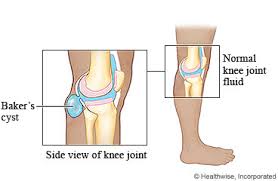Bakers Cyst
A Baker’s Cyst is swollen semimembranosus gastrocnemius bursa. Synovial bursae are sacs that generally occur near our joints and sometimes communicate with the joint cavity. They typically sit at sites of anatomical friction and are designed to reduce friction. A swollen and painful bursae is known as a bursitis or bursopathy and can result from a number of causes.
A Baker’s Cyst is swollen semimembranosus gastrocnemius bursa. Synovial bursae are sacs that generally occur near our joints and sometimes communicate with the joint cavity. They typically sit at sites of anatomical friction and are designed to reduce friction. A swollen and painful bursae is known as a bursitis or bursopathy and can result from a number of causes including:
- Inflammatory arthritis
- Gout Pseudogout Infection
- Acute trauma Mechanical irritation through friction
- Pathology in the joint or tendon in which the bursae communicates
In children Baker’s Cysts usually occur through irritation of the bursa. In adults they occur as the result of a chronic knee swelling, usually with a posterior horn medial meniscal tear.
Pain and Symptoms
Symptoms can include some or all of the following:
- Pain if present will usually be around the back of the knee
- It is usually tender to touch over the region
- There may be a visual lump in the back of the knee
Diagnosis
MRI will confirm both the presence of the cyst and also will be able to identify the underlying pathology in the knee which is causing the cyst to develop.
Treatment
This often requires no treatment. If there is no pain or loss of function they can generally be ignored. If treatment is necessary it will consist of treatment to the underlying problem (eg the meniscal tear).

